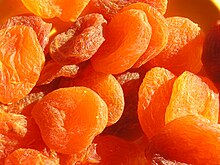Intermediate moisture food

Intermediate moisture foods (IMF) are
Shelf-life and safety
The purpose of IMF foods is to achieve a water activity that the food can be stored safely without refrigeration. However, the food is not sterile.
Processing
Partial drying
To achieve 0.6-0.84 water activity in food products, partial drying is employed for raw food that naturally have a high amount of humectants such as raisins, apricots, prunes and sultanas.[3] Humectants are solutes (such as sugar or salt) that immobilize water in food. The drying process removes free water, and the humectants in the product bind the rest of the water, not allowing it to be utilized for chemical reactions or for microbial use.[2]
Osmotic drying using a humectant
Osmotic dehydration is the process of soaking food in highly concentrated solutions of humectant. Salt and sugar are commonly used humectants for this process. Water diffusion from the food to the humectant solution is caused by osmotic pressure. The water is replaced by the humectant, which results in a lowered water activity for the food product.[3] Osmotic dehydration process results in two way mass transfer in regards to the moisture lost and the solids gained, with moisture loss being much greater than the addition of solids.[6] Advantages of osmotic dehydration include low processing temperatures, short drying times, and 20-30% lower energy consumption than typical dehydration processes.[6] Sugar is used as the humectant for candied intermediate moisture fruits, and salt is used for intermediate moisture vegetables and fish.[3] Additionally, a mixture of humectants can be formulated to manipulate the sensory properties of the food product.[2] Osmotic drying using a humectant results in a soft texture in the final product.[2]
Dry infusion
Dry infusion is the combination of partial dehydration and osmotic dehydration using a humectant. The food product is first dehydrated and then the resultant product is added to a humectant solution to reach the desired water activity.[2] This method is desirable because it results in a higher quality and more appealing product. However, more energy is used for this method because it is two processing steps combined. Dry infusion is primarily employed by the U.S military and NASA for production of IMF to produce safe, palatable food that can be consumed much later than it is produced.[2]
Formulated intermediate moisture foods
Many types of food are specially formulated to achieve water activity in the IMF range. Food ingredients are mixed with salt and/or sugar, and additives (such as propylene glycol and potassium sorbate) and then subjected to processing methods such as cooking, extrusion or dehydration to result in an intermediate moisture final product. Examples of formulated IMF are confectioneries and pet food.[2]
Applications
Fruits and vegetables

Sugar is added to fruit to protect against microbial contamination and reduce water activity in the fruit. This allows the fruit to be more stable at room temperature. Some examples are strawberries, prunes, peaches, apricots, and pineapples.
Meat

Fermented meats, sausage, jerky, and corned beef can last many months without refrigeration.[9] Pastirma is a beef product that is often eaten raw in the Middle East and Mediterranean countries.[10] It is made from the hindquarter of beef cattle. Pastirma is a type of intermediate moisture food and can be stored for several months in humid climates. The meat is salted and dried to reduce water activity and increase microbial safety. Additionally, nitrites are added for preservation. The final product has 5% salt and a moisture content between 30-35%.[10]
Pet food
Semi-moist pet food such as chewy dog treats and soft cat treats are shelf-stable, soft and do not have a high moisture content.[11] Ingredients added to intermediate moisture pet food to achieve lower water activity are soy flakes and wheat flour in addition to solutes such as glycerol, salt, and sugar.[2] Processing techniques such as extrusion are employed to attain the final intermediate moisture pet food.[2] Intermediate moisture pet food are convenient products because they leave less odor and are less messy than canned wet pet food. Additionally, they have been found to be more palatable to pets than dry pet food products.[2]

Baked goods and confectioneries
Cakes are considered to be intermediate moisture foods because of their moisture content (18-28%), and have low enough water activity that preserve the safety and quality.
| Range | Food |
|---|---|
| 0.85-0.75 | Sweet condensed milk, fruit cake, salted fish, molasses, jams, dog food, dried fruit, icings, soy sauce, jam |
| 0.75-0.65 | Dates, figs, nuts, parmesan cheese, dulce de leche |
| 0.60-0.65 | Honey, chocolate bars, marshmallows, biscuits |
Advantages
Intermediate moisture foods utilize hurdle technology by lowering water activity, reducing pH and using preservatives. Most bacteria do not grow under a water activity of 0.90 and IMF processing methods reduce water activity to 0.60-0.84.
Concerns
Since microbes, namely Salmonella and Bacillus cereus, can persist in IMFs, other hurdles including reduction in pH and the use of preservatives is not unusual.
References
- ^ "Hazard Analysis and Risk-Based Preventive Controls for Human Food: Draft Guidance for Industry" (PDF). Food and Drug Administration.
- ^ a b c d e f g h i j k l m n o p q Barbosa-Canovas, Gustavo; Fontana Jr., Anthony J.; Schmidt, Shelly J.; Labuza Theodore P. (2007). Water Activity in Foods (PDF). IFT Press/Blackwell Publishing. pp. 273–305.
- ^ )
- ^ World Health Organization, Food and Agriculture Organization of the United Nations (2015). "Code of Hygienic Practice for Low-Moisture Foods" (PDF). Codex Alimentarius.
- PMID 10791741.
- ^ PMID 23572596.
- ^ Barbosa-Cánovas, Gustavo V.; Fernández-Molina, Juan J.; Alzamora, Stella M.; Tapia, Maria S.; López-Malo, Aurelio; Chanes, Jorge Welti (2003). Handling and Preservation of Fruits and Vegetables by Combined Methods for Rural Areas. Rome, Italy: FAO Agricultural Services Bulletin 149.
- ^ )
- ISBN 9781845691592.
- ^ OCLC 50479233.
- )
- ISBN 9780122270550.
- )
- .
- PMID 548837.
- PMID 24834193.
